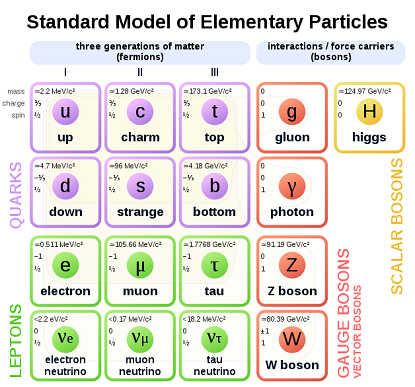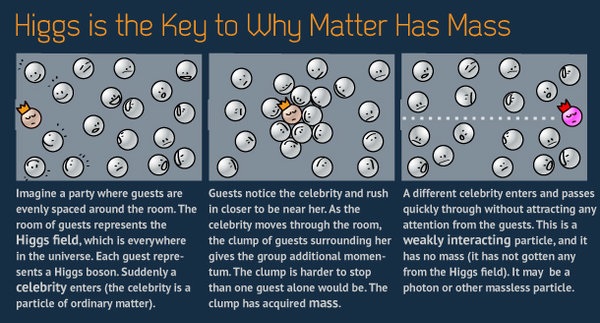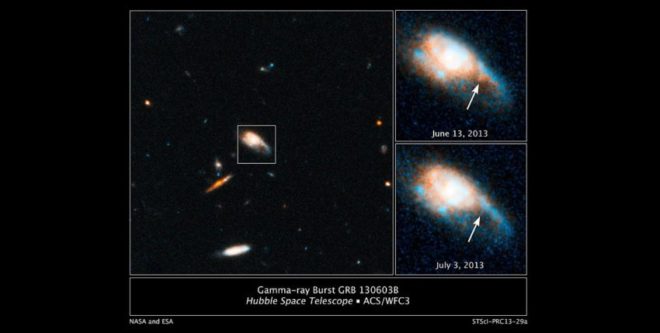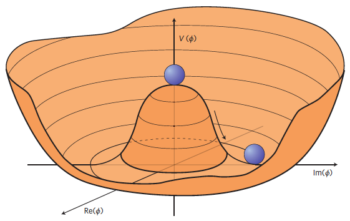This is the fourth and final section of mysteries of physics. I’m working through the 18 biggest unsolved mysteries in physics by Natalie Wolchover and Jesse Emspak. In doing so I’m forming an opinion that some mysteries are nothing of the kind. I’m also forming an opinion that some physicists and institutions peddle mystery in order to promote themselves, because they aren’t doing useful science. More on that another day. Meanwhile, on with the show:
When sound waves make light
Though particle-physics questions account for many unsolved problems, some mysteries can be observed on a bench-top lab setup. Sonoluminescence is one of those. If you take some water and hit it with sound waves, bubbles will form. Those bubbles are low-pressure regions surrounded by high pressure; the outer pressure pushes in on the lower-pressure air, and the bubbles quickly collapse. When those bubbles collapse, they emit light, in flashes that last trillionths of a second.
The problem is, it’s far from clear what the source of the light is. Theories range from tiny nuclear fusion reactions to some type of electrical discharge, or even compression heating of the gases inside the bubbles. Physicists have measured high temperatures inside these bubbles, on the order of tens of thousands of degrees Fahrenheit, and taken numerous pictures of the light they produce. But there’s no good explanation of how sound waves create these lights in a bubble.
I have to say sonoluminescence isn’t my kind of thing. I deal in fundamental physics, and this isn’t it. Whilst it’s an interesting phenomenon with potential applications, it feels like sonoluminescence just isn’t in the same league as the other mysteries.
 Sonoluminescence image from the Putterman Research Group at UCLA
Sonoluminescence image from the Putterman Research Group at UCLA
It also feels like sonoluminescence is a cousin of triboluminescence. The latter is classed as materials science, and current theory says it’s to do with charge separation, followed by an electrical discharge. A spark, as it were. It’s fairly common, being exhibited when unpeeling Scotch tape or crushing sugar. One of the proposed mechanisms for sonoluminescence is somewhat similar, involving ionization and bremsstrahlung radiation. Since I don’t light up the room when I pour myself a beer, that’s good enough for me.
What lies beyond the Standard Model?
The Standard Model is one of the most successful physical theories ever devised. It’s been standing up to experiments to test it for four decades, and new experiments keep showing that it is correct. The Standard Model describes the behavior of the particles that make up everything around us, as well as explaining why, for example, particles have mass. In fact, the discovery of the Higgs boson — a particle that gives matter its mass — in 2012 was a historic milestone because it confirmed the long-standing prediction of its existence.
But the Standard Model doesn’t explain everything. The Standard Model has made many successful predictions — for example, the Higgs boson, the W and Z boson (which mediate the weak interactions that govern radioactivity), and quarks among them — so it is difficult to see where physics might go beyond it. That said, most physicists agree that the Standard Model is not complete. There are several contenders for new, more complete models — string theory is one such model — but so far, none of these have been conclusively verified by experiments.
What lies beyond the Standard Model? Nothing. Because it’s dripping with errors and omissions. It doesn’t tell you what a photon is, or how pair production works. Instead it tells you an electron is a point particle when it isn’t, and that it’s an excitation of the electron field when it isn’t. It doesn’t tell you what happens in electron capture, or what charge is, or how electromagnetism works. Instead it’s full of lies to children about messenger particles that don’t exist. It’s said to be “one of the most successful physical theories ever devised”, but we’ve never actually seen a quark or a gluon. Or a W-boson, or a Z boson, or a Higgs boson. The existence of these things has been inferred from decay products or less. The Higgs boson “discovery” was just a bump on a graph.
 Standard model particles image by MissMJ, see Wikipedia Commons
Standard model particles image by MissMJ, see Wikipedia Commons
The Standard Model is also said to describe “the behavior of the particles that make up everything around us”. However it doesn’t explain why electrons and positrons spiral in opposite directions in a magnetic field. Nor does it explain why particles have mass. Einstein explained that in 1905: the mass of a body is a measure of its energy-content. Remember pair production and the wave nature of matter. Remember what Hans Ohanian said about spin being a circulating flow of energy. Then think of photon energy as resistance to change-in-motion for a wave moving linearly at c, and electron mass as resistance to change-in-motion for a wave going around and around at c. It’s that simple. However the Standard Model flatly contradicts E=mc². Not only that, but as Gian Giudice said in A Zeptospace Odyssey, the Higgs sector looks frightfully ad hoc, the Higgs mechanism accounts for only 1 per cent of the mass of ordinary matter, and the Higgs boson is like the toilet of the Standard Model edifice. That’s because gauge bosons ought to be massless, but a short range force needs them to be massive. Hence the Higgs mechanism is just another kludge, like renormalization was a kludge. It’s “explained” using more lies to children, about cosmic treacle and party guests:
 Higgs party-and-guests image from Will the Real Higgs Please Stand Up? By Karl Tate
Higgs party-and-guests image from Will the Real Higgs Please Stand Up? By Karl Tate
No, “the Standard Model doesn’t explain everything”, because it doesn’t explain anything. It doesn’t explain how the nuclear force works, or how gravity works, and it doesn’t even explain how a magnet works. Or what energy is. Its predictions are said to be successful, but you’ve never seen a quark or a gluon, or any particle with a lifetime of 10ˉ²⁵ seconds. Instead you’ve seen Carlo Rubbia and the discovery of the W and Z by Gary Taubes, who tells how Rubbia sold the “discovery” of the W boson to a willing audience at CERN. Rubbia got a standing ovation, even though what had actually been observed was a high-energy electron. Yes, it’s “difficult to see where physics might go beyond it” because particle physicists have painted themselves into a corner with the Standard Model. They cannot admit that there’s anything dubious about any of their “discoveries” that have been set in stone by Nobel prizes. Hence fundamental physics has been stuck in an impasse for forty years. Yes, perhaps “most physicists agree that the Standard Model is not complete”, but they will not admit to its faults. So they can’t pick the low-hanging fruit that could get physics out of a hole. Instead they can’t stop digging, and they can’t even admit that the low hanging fruit is there. They can not see that the Standard Model is going nowhere, and that we need to scrap it and start again.
Fundamental constants
Dimensionless constants are numbers that don’t have units attached to them. The speed of light, for example, is a fundamental constant measured in units of meters per second (or 186,282 miles per second). Unlike the speed of light, dimensionless constants have no units and they can be measured, but they can’t be derived from theories, whereas constants like the speed of light can be.
In his book “Just Six Numbers: The Deep Forces That Shape the Universe” (Basic Books, 2001), astronomer Martin Rees focuses on certain “dimensionless constants” he considers fundamental to physics. In fact, there are many more than six; about 25 exist in the Standard Model. [The 9 Most Massive Numbers in Existence]
For example, the fine structure constant, usually written as alpha, governs the strength of magnetic interactions. It is about 0.007297. What makes this number odd is that if it were any different, stable matter wouldn’t exist. Another is the ratio of the masses of many fundamental particles, such as electrons and quarks, to the Planck mass (which is 1.22 x 1019 GeV/c2). Physicists would love to figure out why those particular numbers have the values they do, because if they were very different, the universe’s physical laws wouldn’t allow for humans to be here. And yet there’s still no compelling theoretical explanation for why they have those values.
The speed of light is not constant. Einstein said it time and time again. It varies in the room you’re in. If it didn’t, light wouldn’t curve and your pencil wouldn’t fall down. The folk who say the speed of light is constant just don’t get the tautology: if you use the local motion of light to define the second and the metre, and then use them to measure the local speed of light, you’re always going to get the same answer. Duh! So you’ll forgive me if raise an eyebrow when somebody says dimensionless constants “can’t be derived from theories”. Especially when Martin Rees talked about the cosmological constant lambda Λ as an absolute constant even though the expansion of the universe is increasing. He also talked about density parameter omega Ω, which is said to be 1 to pencil-point precision, even though energy is always conserved. On top of that, he talked about the fine structure constant α = e²/4πε0ħc, which is a running constant. It “depends upon the energy at which it is measured”, and so must surely vary with gravitational potential, just like the speed of light. So when somebody tells you “if it were any different, stable matter wouldn’t exist”, take it with a pinch of salt. Unless of course you’re falling into a black hole:, when you’ll find out about that the hard way:
 Public domain Gamma Ray Burst image thanks to NASA and ESA, see Wikipedia and Wikipedia Commons
Public domain Gamma Ray Burst image thanks to NASA and ESA, see Wikipedia and Wikipedia Commons
Mass ratios are interesting though. I think Andrew Worsley is on to something. He’s a medical doctor with a deep interest in physics, and he’s come up with some very interesting expressions. Imagine the speed of light c was dimensionless. Then take a look at c½ / 3π = 1837.127 and c⅓ / π = 213.037. Have you seen numbers like that before? Some people dismiss this sort of thing as mere numerology, but I don’t. That’s because I think of William Kingdon Clifford’s space theory of matter. That’s where he talked of waves in space and said “nothing else takes place”. Mass ratios must surely be related to some kind of spherical or toroidal harmonics where all components of wave motion mesh like gears. Especially since the Planck length is √(ħG/c³). Replace the √(ħG) with 4πn, where n has the correct dimensionality but a value of 1. Then get your calculator out: 4πn / c1½ = 2.42 × 10-12 m. Seen that before? As to how derive precise g-factor-compliant numbers in a rock-solid fashion, that’s one for a rainy day.
What the heck is gravity, anyway?
What is gravity, anyway? Other forces are mediated by particles. Electromagnetism, for example, is the exchange of photons. The weak nuclear force is carried by W and Z bosons, and gluons carry the strong nuclear force that holds atomic nuclei together. McNees said all of the other forces can be quantized, meaning they could be expressed as individual particles and have noncontinuous values.
Gravity doesn’t seem to be like that. Most physical theories say it should be carried by a hypothetical massless particle called a graviton. The problem is, nobody has found gravitons yet, and it’s not clear that any particle detector that could be built could see them, because if gravitons interact with matter, they do it very, very rarely — so seldom that they’d be invisible against the background noise. It isn’t even clear that gravitons are massless, though if they have a mass at all, it’s very, very small — smaller than that of neutrinos, which are among the lightest particles known. String theory posits that gravitons (and other particles) are closed loops of energy, but the mathematical work hasn’t yielded much insight so far.
Because gravitons haven’t been observed yet, gravity has resisted attempts to understand it in the way we understand other forces – as an exchange of particles. Some physicists, notably Theodor Kaluza and Oskar Klein, posited that gravity may be operating as a particle in extra dimensions beyond the three of space (length, width, and height) and one of time (duration)we are familiar with, but whether that is true is still unknown.
It’s easy to explain how gravity works. Einstein spelled it out a hundred years ago. A gravitational field is where a concentration of energy in the guise of a massive star conditions the surrounding space, this effect diminishing with distance. As a result space is neither homogeneous nor isotropic, so the speed of light is spatially variable. So light curves downwards like any wave curves when there’s a gradient in wave speed. Then matter falls down because of the wave nature of matter. Again, remember what Hans Ohanian said about spin being a circulating flow of energy. Then think in terms of light going round a square path, wherein the horizontals curve downwards:

Other forces are not mediated by particles. See the peculiar notion of exchange forces part I and part II by Cathryn Carson. The exchange-particle idea worked its way into QED from the mid-1930s, even though Heisenberg used a neutron model that was later retracted. Electromagnetism is not the exchange of photons. Electrons and positrons move the way that they do because of the screw nature of electromagnetism. Because the electromagnetic field is not unlike the frame-dragged gravitomagnetic field. And because the electron is a dynamical “spinor”. So is the positron, albeit with the opposite chirality. They don’t throw photons back and forth. Hydrogen atoms don’t twinkle. Magnets don’t shine. The exchange particles of QED only exist in the mathematics of the model. They are virtual. As in not real. So are the gluons in ordinary hadrons. As for W and Z bosons, do you seriously believe that a 939 MeV neutron decays because an 80 GeV W boson pops out of a quark, then decays into an electron and an antineutrino with a combined mass-energy of circa 1 MeV? So quickly that you can’t actually see the W boson? It’s a fairy tale. In similar vein there are no gravitons flying around the room you’re in. Nobody has found a graviton yet, and they never ever will, because quantum gravity is a castle in the air. It has no foundations. Gravity has resisted attempts to understand it “in the way we understand other forces” because you don’t understand other forces.
Do we live in a false vacuum?
The universe seems relatively stable. After all, it’s been around for about 13.8 billion years. But what if the whole thing were a massive accident? It all starts with the Higgs and the universe’s vacuum. Vacuum, or empty space, should be the lowest possible energy state, because there’s nothing in it. Meanwhile, the Higgs boson — via the so-called Higgs field — gives everything its mass. Writing in the journal Physics, Alexander Kusenko, a professor of physics and astronomy at the University of California, Los Angeles, said the energy state of the vacuum can be calculated from the potential energy of the Higgs field and the masses of the Higgs and top quark (a fundamental particle).
So far, those calculations appear to show that the universe’s vacuum might not be in the lowest possible energy state. That would mean it’s a false vacuum. If that’s true, our universe might not be stable, because a false vacuum can be knocked into a lower energy state by a sufficiently violent and high-energy event. If that were to happen, there would be a phenomenon called bubble nucleation. A sphere of lower-energy vacuum would start growing at the speed of light. Nothing, not even matter itself, would survive. Effectively, we’d be replacing the universe with another one, which might have very different physical laws. [5 Reasons We May Live in a Multiverse]
That sounds scary, but given that the universe is still here, clearly there hasn’t been such an event yet, and astronomers have seen gamma-ray bursts, supernovas, and quasars, all of which are pretty energetic. So it’s probably unlikely enough that we wouldn’t need to worry. That said, the idea of a false vacuum means that our universe might have popped into existence in just that way, when a previous universe’s false vacuum was knocked into a lower energy state. Perhaps we were the result of an accident with a particle accelerator.
Yes, the universe seems relatively stable. As for whether the Big Bang was some massive accident, I don’t know. I’m not even sure the universe has been around for 13.8 billion years. What if light moved very slowly in the early universe? What if time dilation was infinite, like at black hole event horizon? As for space being “the lowest possible energy state, because there’s nothing in it”, that’s not true. The energy density of space varies in a gravitational field. It isn’t zero. Not only that, but the Higgs mechanism contradicts E=mc², and as Gian Giudice said, it accounts for only 1 per cent of the mass of ordinary matter. So the Mexican hat cuts no ice:
 Higgs Mexican hat image from the CERN article the historical profile of the Higgs boson
Higgs Mexican hat image from the CERN article the historical profile of the Higgs boson
So no, the energy state of the vacuum can’t be calculated from the potential energy of the Higgs field and the masses of the Higgs and top quark. That’s phooey. And of course the universe’s vacuum isn’t in the lowest possible energy state. If it was, it wouldn’t be expanding. But yes, I suppose it could change due to some event. The fate of the universe might be the Big Rip. But claiming bubble nucleation would occur is a stretch. That’s inflation talk, and I’m afraid to say that when you dig into inflation, you find it’s a solution to problems that do not exist. Not only that, but Guth’s model didn’t work, because it had bubbles forming in a supercooled environment, which is the exact opposite of boiling. It was all downhill from there, hence it degenerated into multiverse pseudoscience. But OK, maybe the Big Bang was the result of an accident with a particle accelerator. I can’t prove it wasn’t. But hey, best not build that new collider then. It’s a waste of money anyway. I agree with Sabine Hossenfelder on this. I’m probably the only one who agrees with her, and then some. Because I think it’s worse than a waste of money. Because it props up bad science that stands in the way of scientific progress.